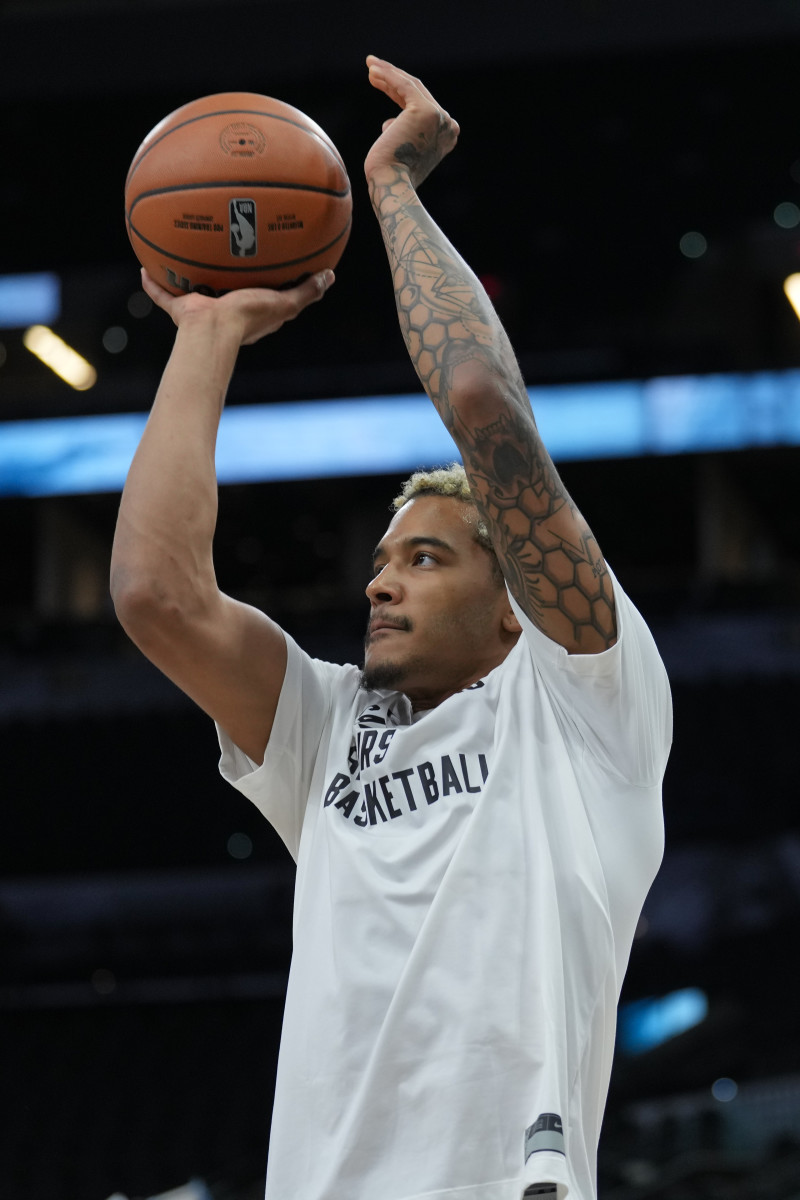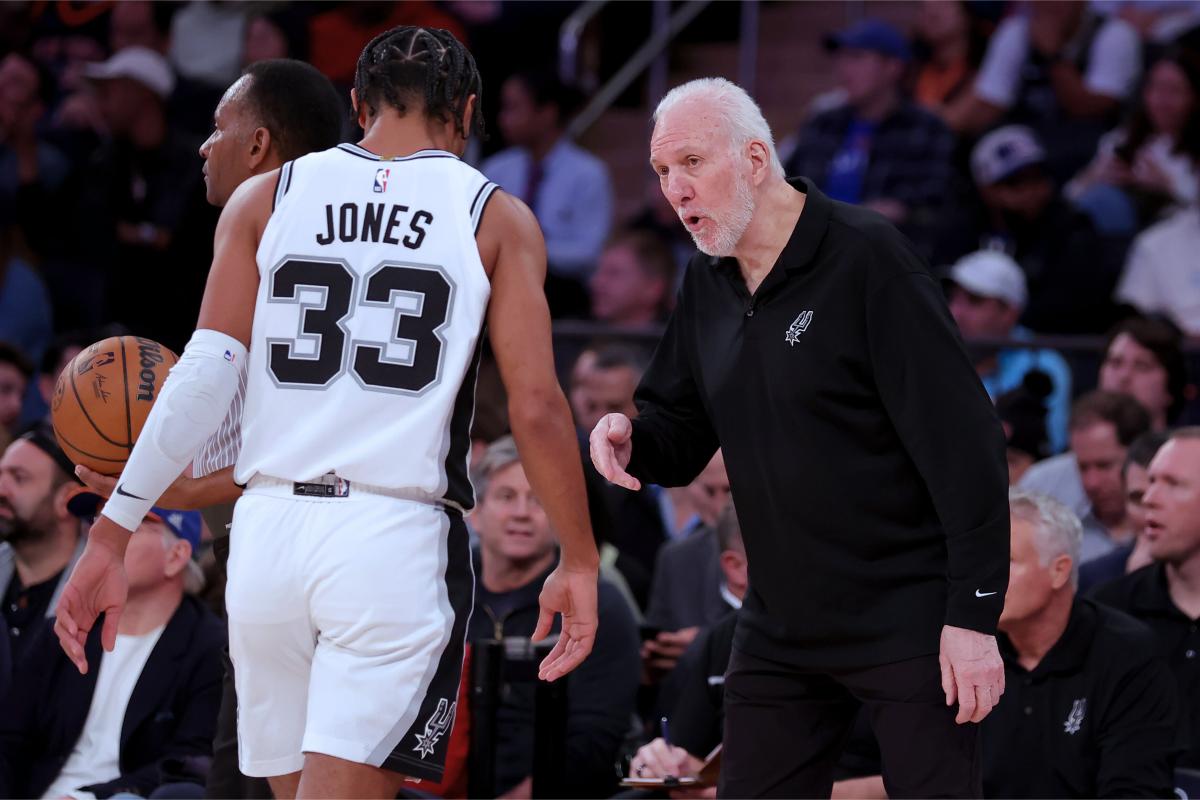Why San Antonio Spurs' Jeremy Sochan Experiment Doesn't Have to Work Just Yet

The preseason, not-yet-debuted version of the San Antonio Spurs garnered a myriad questions regarding their lineup, game plan and on-court dynamic.
Who starts alongside Victor Wembanyama? What's his rookie impact? Is he a point?
All three were valid queries, and all three were expected. The only thing was, there wasn't one set answer — and there still isn't, even nine games into the season.
San Antonio's commitment to building around Wembanyama was evident from the very beginning. The question was never about how much he would play or if he would start — he was going to begin every game at center court. Where the debate came from was who was going to be put around him, and where.
Zach Collins was a big part of that discourse. Just the season prior, he had taken over for a traded Jakob Poeltl and seemingly found his rhythm. Suddenly, he wasn't an ex-Portland Trail Blazer searching for a new team. He had found it — but then that same team found themselves atop the NBA's Draft Lottery with a generational "center" up for grabs.
On the flip side, San Antonio was seemingly carving out a space for Devin Vassell, who showed incredible promise in the back half of the season as well. All of that, mixed with a second-year Jeremy Sochan who needed a chance to prove himself without injuries interfering, and the Spurs had themselves a predicament.
That's not even mentioning Keldon Johnson. And the result?
We'll call it "The Jeremy Sochan Experiment." Sorry, Tre Jones.

How Does It Work?
Simply put, "The Jeremy Sochan Experiment" involves ... well, Jeremy Sochan.
A year ago, the Spurs selected a forward out of Baylor University with the No. 9 pick in the NBA Draft. Coming from Poland, not only was his personality unique, but his skillset was, too. Sochan brought a level of defense that was atypical for small forward.
He had a 7-foot wingspan and always active hands, which he used to generate defensive takeaways and, by proxy, transition offense. His offense was the weak point, however. Between a mediocre-at-best pull-up jump shot and relatively disorganized off-ball play, it was clear that his area of improvement was largely on that side of the court.
So, as much as he did play last season when he wasn't out with injury, he focused on that. His free throw shot became one-handed and his primary impact came on the boards and on defense. But Spurs coach Gregg Popovich saw more potential in him.
"[Jeremy] has been a great player to watch," Popovich said of Sochan's performance last season. "He does so many different things. You don't know what he's going to do exactly ... He's a rebounder. He's a defender. He's not afraid to make mistakes."
Embracing the learning process is arguably the No. 1 trait of a coachable player, and safe to say, Jeremy was coachable. He was ready for a different role with San Antonio.

"I think my role might change a little bit," Sochan said at the end of last season. "I might be more of a leader. I’ll be playing with the ball a bit more and be that playmaker. I’m going to stay aggressive and be ready for more minutes and be ready to get beaten up a little bit."
Okay. Sochan is ready. Make him point guard. That's the logical train of thought, right?
It's a strange idea, and one that made waves on social media as soon as Popovich even flirted with the idea of a forward becoming a point guard.
But Sochan liked it.
"I think I would be comfortable," he said during San Antonio's media day. "I think it would be an experiment. There's going to be days where it looks beautiful, and there's going be days where it's like, 'I don't know about that.'"
On one hand, the benefits were clear. Sochan could handle the ball just well enough to pass, if we're going by grade-school standards, but influence the game better than anyone else on the roster in other ways. He wouldn't be expected to have Kyrie Irving-esque handles or Steph Curry's quickness — just his head straight on and poised.
“Especially with that kind of size in the lineup, It'd be important to protect the paint and be able to show the presence of our length, our hands, and make it chaotic for [opposing teams]," Sochan said. "We’[d be] trying to be big and aggressive to the point where the paint is ours."
On the other hand, that was a well-oiled machine waiting to happen on paper only.
Sochan at the one would allow Wembanyama to breathe and play freely with Zach Collins holding down the fort as a true center. Devin Vassell could be the scorer he is, and Keldon Johnson could glue the unit together. But that's before any execution.
“They better play well or we are in trouble," Popovich said of the Spurs' tall ball lineup. "Those are the big guys. They're tall, they're big, [and] they're going to start."
"Go big or go home," they say. San Antonio chose the former, though it hasn't been smooth sailing. Not at all.
It Doesn't Have To Pay Off ... Just Yet
There's one player primarily affected by San Antonio's experiment not named Victor Wembanyama. He's also a point guard, and also looking to crack the Spurs' rotation after playing a significant role a year ago.
Tre Jones.
When it came to the Spurs' decision to start Sochan at point guard, Jones was the one receiving the short end of the stick. Sure, he's not an elite point guard, but not only did he lose his starting role, he lost it to a power forward learning the role.
There isn't any bad blood between Jones and Sochan — or anyone for that matter — but Jones being relegated to the bench was an interesting result of an unconventional San Antonio lineup — though Popovich has remained firm in the fact that lineups are more situational than anything else.
"Sometimes you go small, sometimes you play two bigs," Popovich said. "[It] depends on what is going on on the court, and what the matchups are. What works best for the people you have on the court,
"[We're trying] a little bit of everything right now in the beginning of the season.”
Jones has seen his time on the floor this year. In around 25 minutes per game, he's averaged 8.9 points, 6.3 assists and 43 percent shooting — the middle stat saying all it needs to about his point guard capabilities. But whether it's him or Sochan running the show from the one spot, the Spurs haven't found a groove. They aren't consistent.
“The rough start definitely doesn’t help," Jones said. "We got off to a slow start [against the Knicks] and we were digging ourselves out of the hole the entire time."

Jones also commented on the Spurs' first back-to-back, which also revealed its share of woes for the NBA's youngest team.
"The other night was obviously the backend of a back-to-back loss," Jones said. "they came out and hit fourteen threes in the first half so that was tough."
"This is something that we’ll have to get used to," he added. "We’ll have to have this in our minds right away and know that we have to come out and bring it to these teams.”
The Spurs might be self aware, but it doesn't nullify the obvious on-court issue that have come to the forefront of each of their matchups so far this season. But if there truly are that many issues — why does San Antonio insist on leaving Sochan at point?
The answer to that, once again, isn't cut and dry, but it can be thought through. Currently, the Spurs are losing half-court organization with Sochan. He's not a bona fide point guard yet, and lacks some foundational skills and instincts that come with the role, especially down the stretch.
Arguably the biggest example of that came on opening night. San Antonio had the Dallas Mavs right where it wanted them. It had a two-point lead with 1:26 to play in the fourth quarter, and though it went down by two after an Irving 3-pointer, it had the ball once again.
Sochan got a rebound after Johnson's shot was blocked late, but instead of going back up with it or passing out, he froze. Luka Doncic poked the ball out from behind him, and the Mavs went the other way. The Spurs lost, fell to 0-1 and were left wondering what could have been in Wembanyama's first NBA contest.
Case in point. But even with the woes that come with a player learning an entirely new role, the Spurs remain supportive of Sochan and the system with him at point guard.
“It’s something totally different than what he was used to last year," Johnson said of Sochan. "There are going to be ups and downs, and there’s going to be a learning curve. But I think he’s doing a great job, and I think he’s making the right strides to handle those things."
Wembanyama echoed that — taking a broader outlook on the season as a whole.
"It's not a big deal," Wembanyama said. "We're learning. As a young team, and any team really, we're going to go through losing streaks at some point during the season and have tough times.
"It's going to happen, but the most important thing is how we bounce back.”
San Antonio certainly wants to bounce back. It also wants to have Sochan as the point guard, and for no other reason than the potential it sees if "The Jeremy Sochan Experiment" works out.
Yes, Jones is talented and an already-established point guard, but he isn't the piece to push Wembanyama and the Spurs over the edge. He isn't the lone answer to their problems. That's not to say that Sochan is, but he brings a level of potential to the table that would exaggerate not only San Antonio's strengths, but Wembanyama's as well. It'll just take time.
So, remain patient. The experiment is erratic, but it doesn't have to work perfectly.
Not yet, at least.
“It's been five or six games," Popovich said. "[Sochan is] not going to be Chris Paul in six games. He's learning a lot, and he likes the challenge. Every game is an education for him at both ends of the floor."
